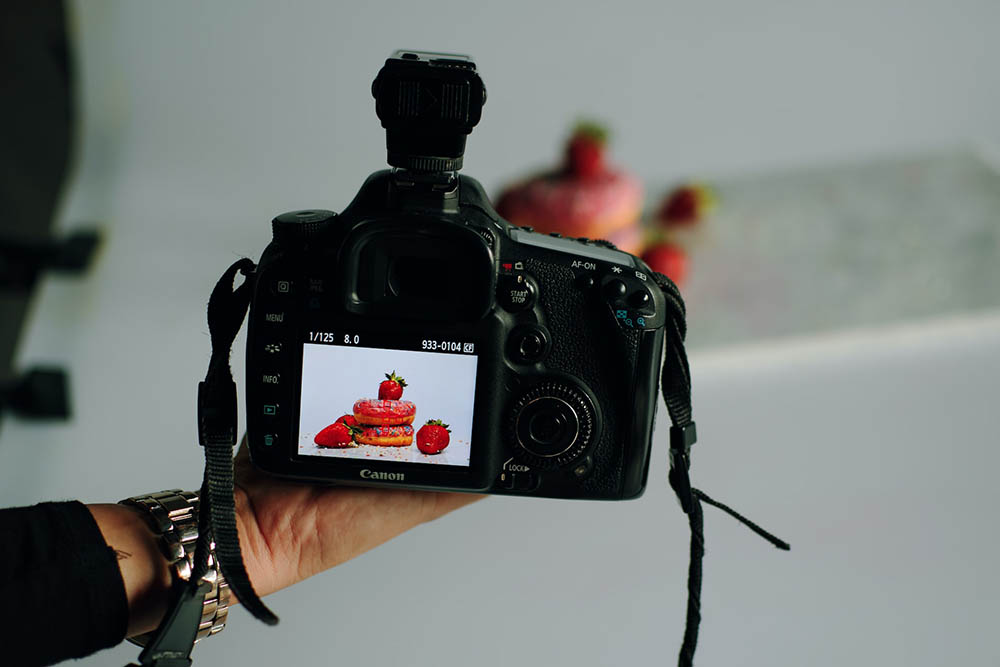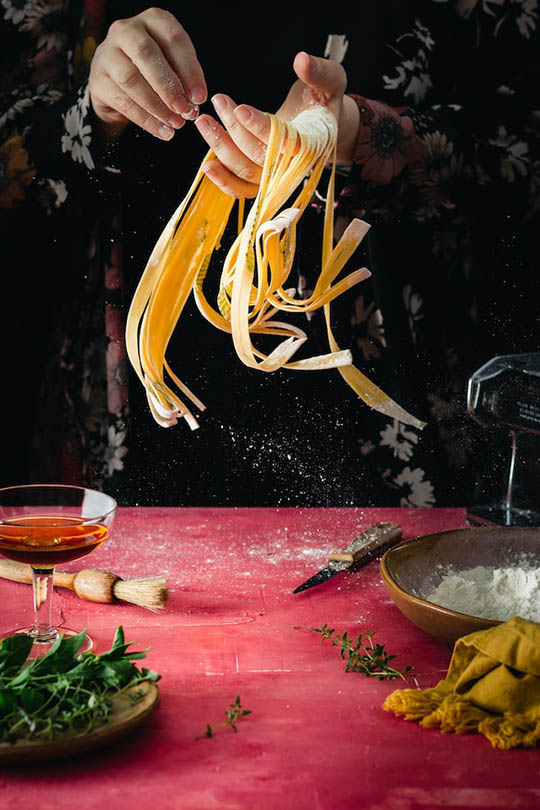17 Food Photography Ideas to Get You Inspired
Last Updated on

Photographing food can be tricky and it is notoriously difficult to make dishes look as mouth-wateringly good in a shot as they do in real life. Not only are viewers limited to their sense of sight without the added allure and appeal of aroma and taste, but getting angles, lighting, and composition right may mean staging, adding props, and even exaggerating the food. Food photography is one occasion when it is acceptable to play with your food if it means you get the best image.
Whether you’re taking photos for a new recipe book, a food-inspired blog, or you simply want to up your #Instafood game, below you will find 17 food photography ideas to inspire you.

The Top 17 Food Photography Ideas to Get You Inspired
1. Conceptual Photography

Food photography can be exciting and appealing. It can also be quite boring, depending on the subject. Conceptual photography can be tricky in itself, but you can add your concept to a photo to deliver a message. Try to make sure the concept itself is relevant to the idea of the photo, or else it can get confusing.
2. Physics Defying Photography

Having your food appear as though it is floating serves several purposes. The viewer’s eye is instinctively drawn to the floating food because it’s an unusual sight. It also means that there are fewer distractions around the food itself, and by blurring or removing the background, it really eliminates unwanted elements of the photograph.
While you can throw the food up in the air and hope for the best, this doesn’t usually yield the best results and is something of a one-shot technique. If you don’t get the shot, the burger is going to be ruined when it hits the floor. It is best to use strings or sticks and remove them during editing.
3. Photograph the Journey

For many people, the joy of food comes in the preparation almost as much as in the eating. Even if you aren’t showing off cookery techniques, using photos of the preparation itself can add a new element to a photo. A tomato on a chopping board wouldn’t look as good as a picture of somebody chopping the tomato.
4. Deconstructed Ingredients

In the same way that deconstructed dishes are popular on the table and in cookery programs, you can use a similar technique in your photography. It will require some post-editing, but the results can be impressive and represent another good way to bring a touch of excitement to an otherwise plain photo of a carrot.
5. Atmospheric Photos

Certain foods and drinks conjure specific emotions in the viewers’ minds. Summer fruits make people think of summery days, while certain alcoholic drinks are reminiscent of nights out and parties. When most people think of coffee, they think of waking up and being energized. When composing a photo, try to introduce the right atmosphere to help get the message across and so that your viewers recognize the picture you’re creating.
6. Different Angles

Angle really matters in photography and especially in still life, and that’s essentially what most food photography is. Different angles of exactly the same picture composition can give very different results, and while none of them are necessarily wrong, you should pick an angle that best shows off the food in the way you want.
7. Use Color

Some food is vividly colored either naturally or artificially, and you can use this to your advantage when taking photos. Set colorful food against a black or white background or, alternatively and somewhat in contradiction to this point, embrace the color and use it to your advantage by setting the picture against an equally colorful background.
8. Go Monochrome

Where the food itself is a single color, it can be difficult to make it the main focal point or the central attraction. One way to achieve this is with monochrome photography, or near monochrome photography. This is especially effective when photographing food that has a somewhat reflective surface because the reflections will bring an added dimension to the finished piece.
9. Use Reflections

Reflections are used in all styles of photography. They increase the size of the subject without introducing any new elements that detract from the picture. You can use mirrors, water, or other liquid, or you can try your hand at editing a reflection into your photo, although editing reflections are difficult to master so that they look realistic.
10. Lines and Frames

Photographic lines are used to direct the eye to the main subject of a picture. Composition frames are used to encapsulate the subject. Although you don’t have to make the frame an actual frame, it does give order to a picture, and it enables the background to work as exactly that—a background that doesn’t steal the limelight from the photo subject.
11. Splashes and Drops

Splashes and drops bring a sense of dynamism to a photograph. While they obviously don’t move in a still picture, they give the appearance of movement. It looks fresh and exhilarating and it makes the picture even more appealing. It can be tricky to get a photo of a good splash, but with practice, you will get the look you’re after.
12. Don’t Be Afraid of Props

Props are used to set a scene and really paint a picture. They are usually chosen to complement the subject itself or an emotion that the photographer wants to convey. They are especially useful when photographing something that might be considered ambiguous or difficult to recognize and are essential when taking pictures of boring and unattractive food items.
13. Be Minimalist

When you’re taking shots of food, it is the food itself that should be the star of the show, and one of the best ways to achieve this is through minimalist composition. Dispense with the props, ensure the lighting is good, and put the food front and center in your image. This can work with most foods but while it might seem simple to photograph a single item with no accoutrements, it can be more challenging than using props and concepts to enhance your image.
14. Add Height

Food can look flat when photographed on a plate or any other surface. One way to avoid this is to naturally introduce height to your photo. Stack up a number of the food item you’re picturing or try to recreate balancing stones using items like doughnuts. It can take practice and a few strategically placed toothpicks or skewers, but the results can be impressive.
15. Spell It Out

Especially useful as a hero or header image, use the ingredients in a dish to literally spell it out. Alternatively, you can use coffee beans to spell coffee, tea to spell tea, and oregano to spell oregano. Just make sure it’s spelled correctly and don’t confuse knowledgeable viewers by using the wrong product to spell the wrong word. Unless that’s your aim.
16. Combine Natural Light and Diffusers

Natural light can make food look fresh and inviting, and it is especially powerful when used to photograph natural produce. However, as effective as natural light is, it’s also difficult to work with. While you can’t ask the sun to move, you can use diffusers and other inexpensive equipment to help soften some of the hard shadows, and you can even use photographic equipment to recreate the natural light.
17. Study Other Work

Food photography is really popular. It combines beautiful images with a love of food, and as well as making a fun hobby, it can become a well-paid career. One of the best ways to find inspiration for pictures and to improve and enhance your own photography skills is to study what others are doing. Look online, check out expensive restaurant brochures, and even look at your local takeout menu. Consider what you like and what you think could be improved in the photos and then set out to improve on them. And, above all else, keep practicing to get the best results.

Conclusion
Food photography can be a professional career, and, to many people, it is a serious hobby. Whether you want to improve how your smashed avocado breakfast looks on Instagram or you want to be the next fast-food chain food photographer, the 17 tips above should provide some inspiration and help take your photography skills to the next level.
Featured Image Credit: Szabo Viktor, Unsplash
Table of Contents
- The Top 17 Food Photography Ideas to Get You Inspired
- 1. Conceptual Photography
- 2. Physics Defying Photography
- 3. Photograph the Journey
- 4. Deconstructed Ingredients
- 5. Atmospheric Photos
- 6. Different Angles
- 7. Use Color
- 8. Go Monochrome
- 9. Use Reflections
- 10. Lines and Frames
- 11. Splashes and Drops
- 12. Don’t Be Afraid of Props
- 13. Be Minimalist
- 14. Add Height
- 15. Spell It Out
- 16. Combine Natural Light and Diffusers
- 17. Study Other Work
- Conclusion
About the Author Robert Sparks
Robert’s obsession with all things optical started early in life, when his optician father would bring home prototypes for Robert to play with. Nowadays, Robert is dedicated to helping others find the right optics for their needs. His hobbies include astronomy, astrophysics, and model building. Originally from Newark, NJ, he resides in Santa Fe, New Mexico, where the nighttime skies are filled with glittering stars.
Related Articles:
How to Clean a Refractor Telescope: Step-by-Step Guide
How to Clean a Telescope Eyepiece: Step-by-Step Guide
How to Clean a Rifle Scope: 8 Expert Tips
Monocular vs Telescope: Differences Explained (With Pictures)
What Is a Monocular Used For? 8 Common Functions
How to Clean a Telescope Mirror: 8 Expert Tips
Brightfield vs Phase Contrast Microscopy: The Differences Explained
SkyCamHD Drone Review: Pros, Cons, FAQ, & Verdict
